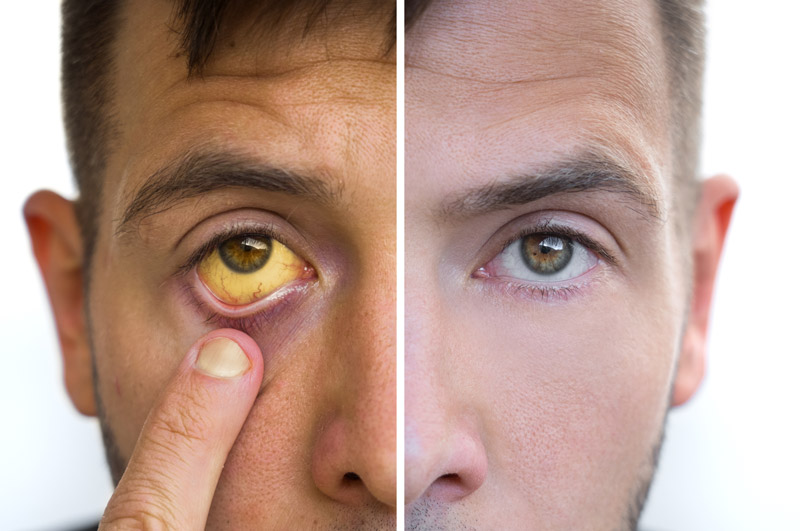Scleral icterus is when the whites of your eyes look yellow. It happens when your liver isn’t correctly filtering a compound called bilirubin out of your blood. This issue can happen at any age but is most likely to happen to newborn babies and adults with certain health issues (most of which are more likely as you get older).
Advertisement
Cleveland Clinic is a non-profit academic medical center. Advertising on our site helps support our mission. We do not endorse non-Cleveland Clinic products or services. Policy

Scleral icterus is a common term for when the whites of your eyes (sclera) look like they’re turning yellow. It happens with liver-related conditions and similar digestive tract issues. People often refer to this as “jaundice,” but that term can refer to yellowing of your skin, too. Scleral icterus is specific to your eyes.
Advertisement
Cleveland Clinic is a non-profit academic medical center. Advertising on our site helps support our mission. We do not endorse non-Cleveland Clinic products or services. Policy
Scleral icterus is the more common name used among both medical experts and nonexperts, but the more accurate name is “conjunctival icterus.” The color change is actually in the conjunctiva, a thin, clear membrane that lines the white of your eyes and inside of your eyelids.
Jaundice is a broader term for the yellowing of your eyes and skin from too much bilirubin in your blood. Scleral icterus also describes that yellowing, but it’s only talking about your eyes.
Scleral icterus happens when you have too much bilirubin in your blood (hyperbilirubinemia). Bilirubin is a compound your body makes while breaking down old red blood cells. Your liver is supposed to filter bilirubin out of your blood and release it into bile, which helps with digestion. The bilirubin in your bile eventually breaks down further and leaves your body in your poop.
But if too much bilirubin accumulates in your blood, it can cause color changes like those that happen with scleral icterus. The color changes first affect your eyes and then your skin. If it keeps accumulating, bilirubin can become toxic and even cause confusion and other disruptions in brain activity.
Scleral icterus is one of the earliest and most noticeable signs of a liver issue because:
Advertisement
Some of the most common reasons for high bilirubin levels, which lead to scleral icterus, include:
The treatment for scleral icterus depends mainly on what’s causing it. Because there are so many conditions that can cause it, there are many different treatments. Your healthcare provider is the best person to tell you about the treatment options for your specific case.
Scleral icterus isn’t dangerous on its own, but it can indicate that your liver isn’t working correctly. Without treatment, bilirubin can build up and reach toxic levels. That’s especially dangerous if it affects your brain. Bilirubin toxicity can cause kernicterus in infants and hepatic encephalopathy in adults. Both are extremely serious and need emergency care.
Scleral icterus isn’t 100% preventable, but there are several things you can do to reduce your risk of developing conditions that cause it.
Advertisement
Your liver is a critical organ, and scleral icterus is a sign that something may be wrong with it. You should never try to self-diagnose or self-treat the cause of scleral icterus. If you notice the whites of your eyes turning yellow but don’t have any other symptoms, schedule a doctor’s appointment as soon as you can.
One thing to remember is that the lighting around you can play a role here. “Warmer” lighting or décor are popular because they contribute to a cozy- or relaxed-feeling environment. They can also make your sclera look yellower than they’d look under neutral lighting. You might want to check the color in places with more color-neutral lighting and surroundings to be sure.
Scleral icterus can be a more urgent reason for concern when you have certain other symptoms, too. Even symptoms that might not seem related to each other could still be important.
Symptoms that need prompt medical care when they happen with scleral icterus include:
Advertisement
In adults, scleral icterus can start at a total serum bilirubin of around 3 milligrams per deciliter (mg/dL). A normal total serum bilirubin for anyone more than 31 days old is 0.2 mg/dL to 1.3 mg/dL.
In adults, the total serum bilirubin (TSB) level becomes a serious concern when it goes over 15 mg/dL.
For newborns, it works a little differently. A total serum bilirubin level of 5 mg/dL to 6 mg/dL is normal. Jaundice (including scleral icterus) becomes a serious concern if any of the following happens:
Treatment for newborns usually starts when TSB levels reach 15 mg/dL. If levels go above 20 mg/dL, they can become dangerous. That’s why treatment starts at a much lower TSB level.
Because scleral icterus and jaundice are more complex in newborns, your child’s pediatrician is the best source of information about what your baby needs. They can tell you what to watch for and when to seek medical attention for your baby.
It might be concerning or even alarming to look in the mirror and see the whites of your eyes turning yellow, especially if you don’t feel different or notice other symptoms. But scleral icterus can be an important early symptom of liver issues. That’s because it happens even with relatively small increases in how much bilirubin there is in your blood.
Advertisement
If you notice your sclera looks yellow, schedule an appointment with a healthcare provider and see them at the earliest opportunity. They can run tests to find a cause, determine if it’s serious and find ways to treat it.
If you have a disease that’s affecting your liver, you want expert advice and care. At Cleveland Clinic, we’ll create a treatment plan that’s right for you.

Last reviewed on 07/19/2024.
Learn more about the Health Library and our editorial process.